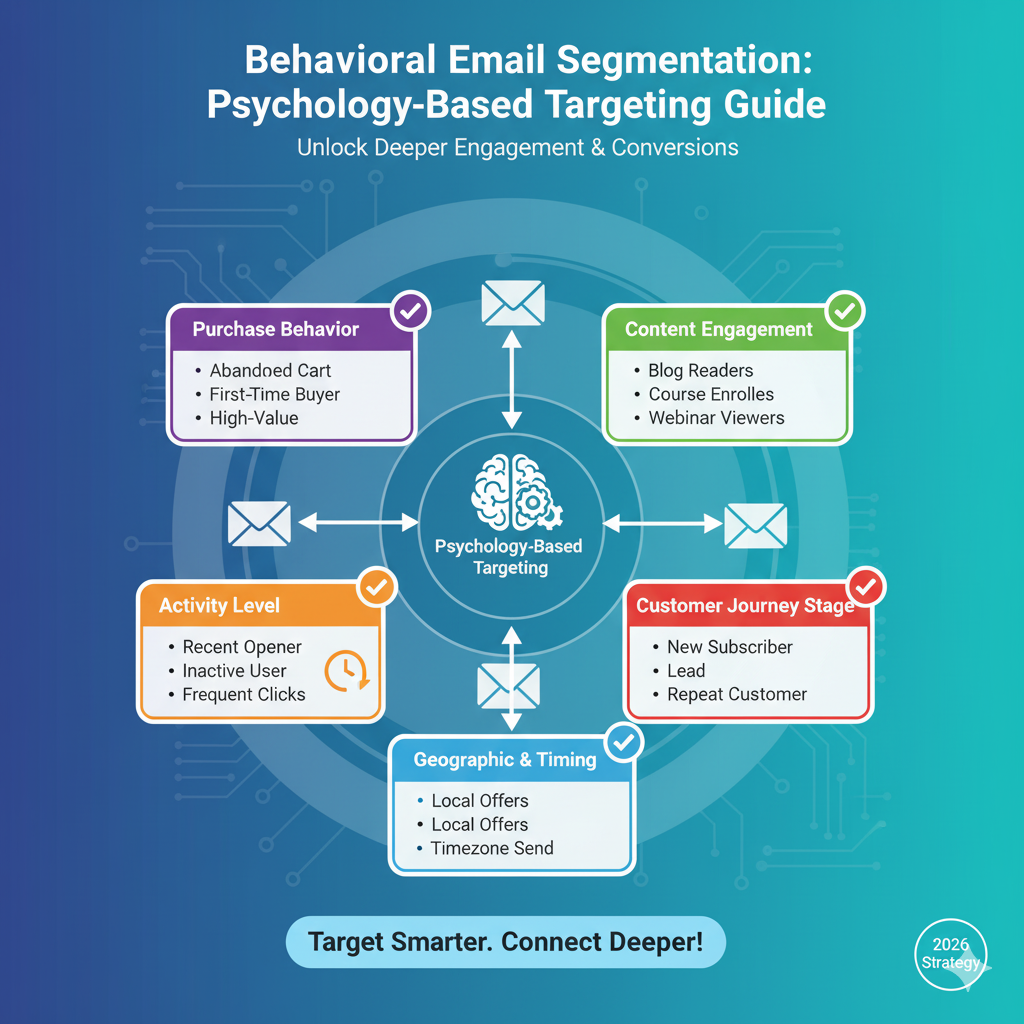Behavioral email segmentation lets you target customers based on their actions and interactions, making your campaigns more effective. You’ll tap into key psychological principles, like anchoring bias and social proof, to enhance your message’s impact. Using reliable data sources, you can gather insights to craft personalized campaigns that truly resonate. You’ll also measure the success of your strategies through metrics like open and conversion rates. Stick around to explore more tips and tricks for optimizing your approach!
Table of Contents
Key Takeaways
- Behavioral segmentation utilizes customer actions, such as past purchases and email engagement, for targeted and effective email marketing strategies.
- Psychological principles, like Anchoring Bias and Social Proof, enhance perceived value and credibility in email campaigns.
- Reliable data sources, including website analytics and social media insights, provide comprehensive behavioral insights for effective segmentation.
- Personalized email strategies, such as tailored subject lines and dynamic content, significantly increase engagement and conversion rates.
- Continuous evaluation of segmentation strategies through metrics like open rates and ROI ensures ongoing improvement and effectiveness in campaigns.
Understanding Behavioral Segmentation
Understanding behavioral segmentation is essential for tailoring your email marketing efforts effectively.
By focusing on customer actions and interactions, you can uncover deeper insights into their preferences.
This approach builds on the Behavioral Foundations of marketing, allowing you to categorize your audience based on their behavior—like past purchases, email engagement, or browsing habits.
As you embrace Segmentation Evolution, you’ll find that more precise targeting leads to higher engagement rates.
Instead of sending generic messages, you can craft personalized content that resonates with each segment.
By analyzing patterns and adapting your strategies, you’re not just reacting to customer needs; you’re anticipating them.
This proactive approach can greatly enhance your email campaigns’ effectiveness, driving better results for your business.
Key Psychological Principles for Targeting
To effectively engage your audience through email, it’s important to examine key psychological principles that influence decision-making.
One powerful concept is the Anchoring Bias, where the first piece of information you present serves as a reference point for your audience.
By strategically using initial offers or prices in your emails, you can shape how recipients perceive value.
Another principle is Social Proof, which taps into the natural tendency to look to others for guidance.
Incorporating testimonials, reviews, or user statistics in your campaigns can enhance credibility and encourage action.
Data Sources for Behavioral Insights
Gathering data sources for behavioral insights is essential for tailoring your email campaigns effectively. To achieve this, you need to focus on source reliability and data integration. Reliable sources provide accurate data, while integrating various data streams helps create a complete view of your audience’s behavior.
| Data Source | Source Reliability | Integration Level |
| Website Analytics | High | High |
| Social Media Insights | Medium | Medium |
| Customer Surveys | Variable | Low |
Crafting Personalized Email Campaigns
With a solid foundation of behavioral insights from your reliable data sources, you’re ready to craft personalized email campaigns that resonate with your audience.
Focus on creating compelling content that draws them in while utilizing effective Email Layouts and Visual Design to enhance engagement.
- Tailor subject lines to reflect user interests and behaviors.
- Use dynamic content to provide personalized recommendations and offers.
- Implement eye-catching visuals that align with your brand and capture attention.
Measuring the Success of Your Segmentation Strategy
How can you determine if your segmentation strategy is truly effective? Start by using benchmarking techniques to establish your baseline metrics. Monitor key performance indicators like open rates, click-through rates, and conversion rates. Then, conduct an ROI evaluation to measure the return on your investment for each segment.
Here’s a simple framework to visualize your progress:
| Metric | Before Segmentation | After Segmentation |
| Open Rate (%) | 15% | 25% |
| Click-Through Rate (%) | 2% | 5% |
| Conversion Rate (%) | 1% | 3% |
Frequently Asked Questions
How Do I Start Collecting Behavioral Data for Segmentation?
To start collecting behavioral data for segmentation, implement ethical collection methods and guarantee you use consent mechanisms. Encourage users to opt-in, providing clear benefits, so they willingly share their information for tailored experiences.
What Are Common Mistakes to Avoid in Behavioral Segmentation?
Avoiding ethical mistakes, like violating privacy, and assumption errors, such as overgeneralizing your audience, can save you from colossal blunders. Focus on accurate data and genuine insights to refine your behavioral segmentation effectively.
How Frequently Should I Update My Segmentation Strategy?
You should update your segmentation strategy at least quarterly, considering seasonal timing and performance impact. Regular adjustments help you stay relevant, ensuring your campaigns resonate with your audience and drive better engagement over time.
Can I Use Behavioral Segmentation for Non-Email Marketing Channels?
Yes, you can definitely use behavioral segmentation for mobile applications and social media. By analyzing user interactions, you can tailor content and promotions, enhancing engagement and driving better results across these channels.
What Tools Can Assist With Behavioral Email Segmentation?
“Don’t put all your eggs in one basket.” You can explore software options like Mailchimp or ActiveCampaign, leveraging their platform features to enhance your behavioral email segmentation and tailor your campaigns to specific audience behaviors effectively.
Conclusion
In the end, you might think that simply sending generic emails will keep your audience engaged. Ironically, it’s the personal touch that truly captivates them. By tapping into behavioral segmentation and psychological principles, you can create campaigns that resonate with individual preferences. So, while you could continue to send out those one-size-fits-all messages, why not embrace the art of personalization? After all, who wouldn’t want to feel like they matter in a crowded inbox?







